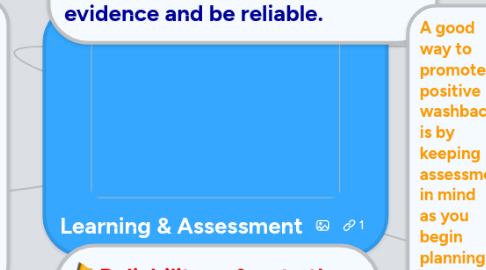Learning & Assessment
by Cary Grenland

1. Criterion-related validity evidence is established by correlating test scores with an external standard or criterion to obtain a numerical estimate of validity evidence.
1.1. Concurrent validity evidence is determined by correlating test scores with a criterion measure collected at the same time.
1.2. Predictive validity evidence is determined by correlating test scores with a criterion measure collected after a period of time has passed.
2. Content validity evidence is assessed by systematically comparing a test item with instructional objectives to see if they match.
3. Validity-Test results should have adequate validity evidence and be reliable.
4. Reliability-refers to the stability of a test score over repeated administrations.
5. Test-retest estimates of reliability are obtained by administering the same test twice to the same group of individuals, with a small time interval between testing, and correlating the scores.
6. Alternate-form estimates of reliability are obtained by administering two alternate or equivalent forms of a test to the same group and correlating their scores.
7. Tests that accurately measure the skills you want to know about and that are used appropriately can have positive results for classroom instruction.
8. Understanding what reliability means and why it is important allows you to explain, for example, why the scores from your morning class are comparable to the test scores of your afternoon class.
9. Construct validity evidence is determined by finding whether test results correspond with scores on other variables as predicted by some rationale or theory.
10. Internal consistency estimates of reliability fall into two general categories:
10.1. Split-half and odd-even estimates divide a test into halves and correlate the halves with one another.methods
10.2. Kuder-Richardson methods determine the extent to which the entire test represents a single, fairly consistent measure of a concept.
11. A good way to promote positive washback is by keeping assessment in mind as you begin planning for instruction.
12. When choosing a test, first think about what you want to know. Next, consider how you will use this information. After defining your needs, see if your purposes match those of the publisher. This way you are more likely to get the information you need about your students and apply it fairly and productively.


